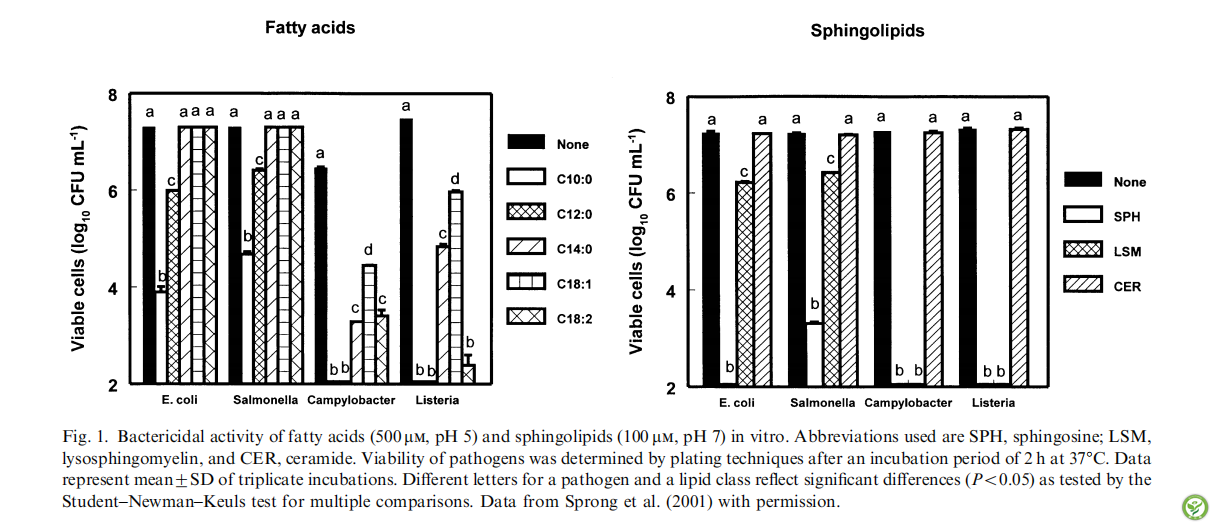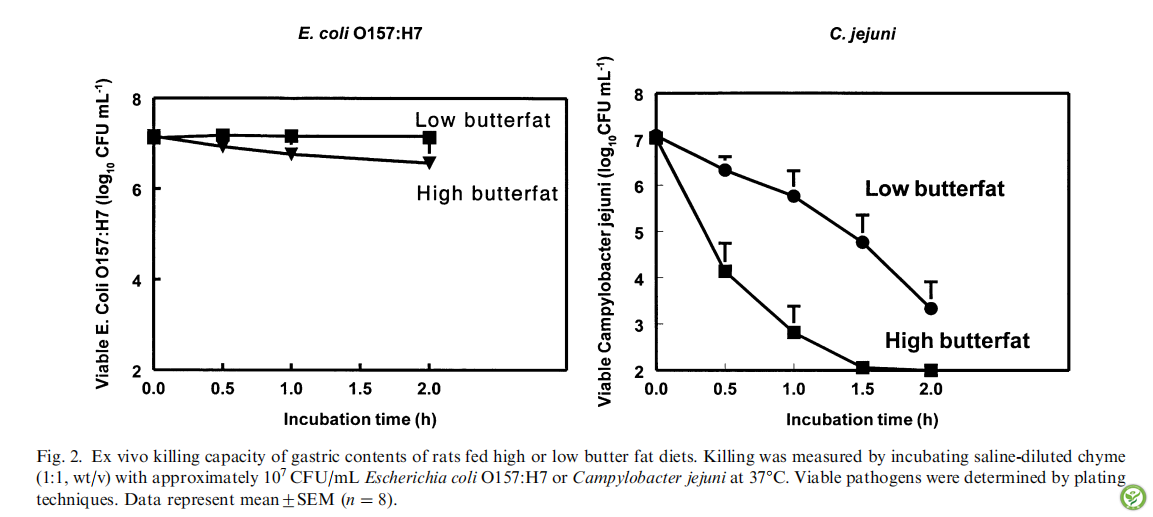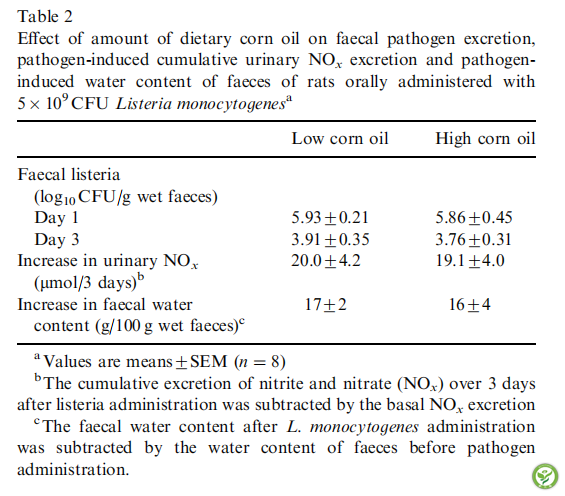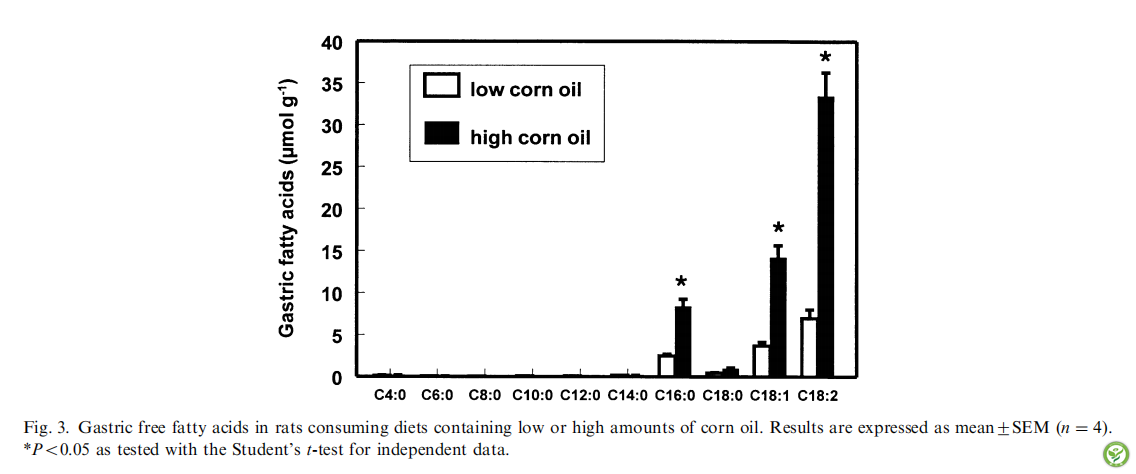Bovine milk fat components inhibit food-borne pathogens
作者:R.C. Spronga, M.F.E. Hulsteina, R. van der Meer a,b
a Department of Flavour, Nutrition, & Ingredients, NIZO Food Research, P.O. Box 20, 6710 BA Ede, Netherlands
b Wageningen Centre for Food Sciences, P.O. Box 557, 6700 AN Wageningen, Netherlands
来源:International Dairy Journal 12 (2002) 209-215
翻译:肠动力研究院 梁琦
【摘要】牛奶脂肪(以下简称牛脂)通过其抗菌成分可防止机体胃肠道感染。这篇文章概述了为测定牛脂的抑菌活性而进行的相关研究。在体外,C10:0,C12:0脂肪酸和不饱和C18脂肪酸以及鞘脂类的消化产物是有效的杀菌剂。单核细胞增生李斯特菌和空肠弯曲杆菌是易感菌,O157:H7大肠杆菌和肠炎沙门氏菌则不易感。高摄入牛脂量的大鼠可防止食源性单核细胞增生李斯特菌的感染,但对肠炎沙门氏菌没有抗性。增强机体对单核细胞增生李斯特菌的抗性与胃内抑菌性饱和脂肪酸分泌量的升高有关。胃的抑菌活性可通过此方法评估:牛脂对在喂食高牛脂或低牛脂日粮的大鼠的胃内容物繁殖的体内单核细胞增生利斯特氏菌,空肠弯曲杆菌和O157:H7大肠杆菌的抗性。饲喂高牛脂日粮的大鼠的胃内食糜对空肠弯曲杆菌的抑菌活性增强,这意味着牛脂可以保护机体免受弯曲杆菌感染,而胃内容物在离体实验中杀死大肠杆菌不受影响。由于在体外不饱和C18脂肪酸具有抑制李斯特菌的功效,因此在大鼠试验中检测了这些药剂的功效。摄入高玉米油不能防止李斯特菌对机体的感染,表明体内具有保护作用的脂肪酸可能局限于C10:0和C12:0。在大鼠中也测试了膜脂质的有效性。与喂食脱牛脂日粮(低膜脂质含量)的大鼠相比,日粮中添加了甜牛脂粉(高膜脂质含量)的大鼠则表现出对单核细胞增生李斯特氏菌的抗性增加。总之,含有C10:0和C12:0的牛脂和鞘脂可增强机体对某些类型的食源性胃肠道感染的抗性。
【关键词】脂肪酸;单甘酯;鞘脂类;胃肠道感染
以下是实验中的相关图表
图1:在体外脂肪酸(500μM,pH=5)和鞘脂(100μM,pH=7)的抑菌活性。使用的缩写是SPH,鞘氨醇; LSM,溶血鞘磷脂和CER,神经酰胺。经过37℃,2小时的发育期后,通过电镀技术检测致病菌的存活数。存活的细菌数量以平均值±SD表示。根据Student-Newman-Keuls的多重比较测试显示:致病菌和脂质类别的不同字母表明两者差异显著(P≤0.05).来自Sprong等人的数据.(2001)获得许可。

表1:日粮中牛脂的含量对粪便中病原微生物排泄量和口服单核细胞增生李斯特菌或肠炎沙门氏菌对大鼠粪便中水含量的影响

图2:饲喂含有高或低牛脂日粮的大鼠的胃内容物的体内杀死致病菌的能力。通过在37℃将生理盐水稀释的食糜和大约107CFU / mL的O157:H7大肠杆菌或空肠弯曲杆菌培育来计算食糜的抑菌能力。通过电镀技术来检测致病菌的存活数。数据用平均值±SEM来表示(n=8)。 
表2:日粮中玉米油的添加量对粪便中致病菌的排泄量,致病菌诱导的尿氮排泄的累积量,和口服5×109 CFU单核细胞增生李斯特菌对大鼠粪便含水量的影响。

图3:日粮中含有低量或高量玉米油的大鼠的胃内游离脂肪酸。结果用平均值±SEM(n=4)表示。*P<0.05是用Student t检验进行测试而获得独立性数据。

启示
研究结果表明:含有C10:0和C12:0的牛奶脂肪可以防止由单核细胞增生李斯特菌引起的食源性胃肠道感染。基于对胃内容物的离体实验,牛脂也可防止空肠弯曲杆菌感染。尽管在体外C18:1和C18:2脂肪酸具有抑菌活性,但用玉米油做的试验结果表明这些脂肪酸在体内并没有抑菌作用。体外试验结果显示,消化产物鞘脂有很强的抑菌活性。综合所观察的结果:与喂食脱牛脂日粮(低膜脂质含量)的大鼠相比,日粮中添加了甜牛脂粉(高膜脂质含量)的大鼠则表现出对单核细胞增生李斯特菌的抗性增加,这些结果表明:奶牛乳中的鞘脂也可防止胃肠道感染。仍需要进一步的研究来检测这些牛脂成分在人体内的抗菌功效。
Abstract
Bovine milk fat may protect against gastrointestinal infections by means of its antimicrobial constituents. This paper summarises our studies performed to test the bactericidal activities of milk fat. In vitro, the fatty acids C10:0, C12:0 and unsaturated C18 fatty acids together with digestion products of sphingolipids were effective bactericidal agents. Listeria monocytogenes and Campylobacter jejuni were very sensitive, whereas E. coli O157:H7 and Salmonella enteritidis were less vulnerable. In rats, high intake of milk fat triglycerides protected against orally administered L. monocytogenes but not against S. enteritidis. The enhanced resistance to L. monocytogenes was related to an increased release of gastric bactericidal saturated fatty acids. Since gastric bactericidal activity is predictive for butter fat-mediated resistance to L. monocytogenes in vivo, C. jejuni and E. coli O157:H7 were incubated with gastric contents of rats fed high or low butter fat diets. Ex vivo killing of E. coli was not affected whereas bactericidal activity towards C. jejuni was enhanced in gastric chyme of rats fed high butter fat diets, implying that milk fat triglycerides may also protect against campylobacter infections. Since unsaturated C18 fatty acids were listericidal in vitro, the efficacy of these agents was tested in rats. High corn oil intake did not protect against listeria infection, suggesting that the protective effect of fatty acids in vivo may be limited to C10:0 and C12:0. The effectiveness of membrane lipids was also tested in rats. Colonisation of L. monocytogenes was decreased in rats fed diets based on sweet butter milk powder (membrane lipid rich) compared with rats fed skim milk-based diets (low content of membrane lipids). In conclusion, bovine milk fat triglycerides containing C10:0 and C12:0, and sphingolipids may enhance the resistance to certain types of food-borne gastrointestinal infections.
Keywords: Fatty acids; Monoglycerides; Sphingolipids; Gastrointestinal infections
Conclusion
Our results indicate that bovine milk fat triglycerides containing C10:0 and C12:0 protect against food-borne gastrointestinal infections caused by L. monocytogenes. Based on our ex vivo experiments with gastric contents, milk fat triglycerides may also protect against C. jejuni. Though C18:1 and C18:2 were bactericidal in vitro, our in vivo results with corn oil indicate that these fatty acids are not effective in vivo. Our in vitro results showed powerful bactericidal activities of digestion products of sphingolipids. Together with the observation that colonisation of L. monocytogenes is decreased in rats fed diets based on sweet butter milk powder (membrane lipid rich) compared with rats fed skim milk diets (low content of membrane lipids), these results suggests that cows’ milk sphingolipids may also protect against gastrointestinal infections. Further research is needed to test the antimicrobial efficacy of these bovine milk fat components in humans.
如您需原文,请联系本文作者和出版方,或请垂询肠动力研究院。本网站发布的所有资料将尽最大可能注明出处、作者及日期,如无意中侵犯了您的知识产权,请来信及时告知,我们将立即予以删除。
All information released by the WeChat Official Account will do its best to indicate the source, author and date. If we inadvertently infringe on your intellectual property, please inform us in time and we will delete it immediately.




